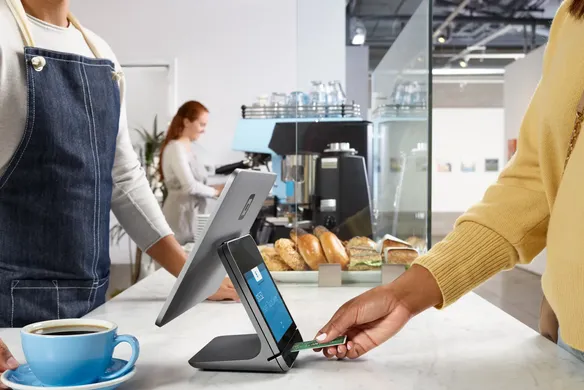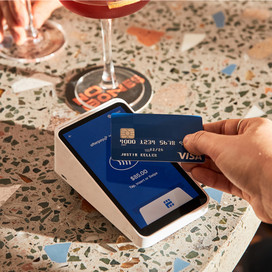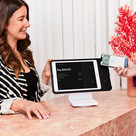Table of contents
In Australia, businesses are allowed to apply a surcharge to EFTPOS and credit card transactions. You’ve probably encountered various forms of this throughout your life as a consumer, but it’s important to understand the rules as a business owner. While surcharges are permitted, there are rules about excessive surcharges, and the penalties for breaching the rules can be quite severe.
Many businesses choose not to impose credit card surcharges, because naturally, they’re not a big hit with customers. So, it’s really a choice between viewing your merchant fees as a cost of doing business and keeping customers happy, or recouping those fees at the risk of alienating some customers.
In this article, we’ll explore what credit card surcharges are, the rules around charging them, and some information about how to set your EFTPOS surcharge if you choose to apply one.
What is a credit card surcharge?
A credit card surcharge is an extra fee you might charge your customers if they pay using EFTPOS or credit cards. With every EFTPOS transaction, your bank or merchant provider charges you a fee, which is usually a percentage of each transaction. So, a credit card surcharge helps to cover those costs.
The merchant fees charged by the most popular card types in Australia are, on average:
- Visa and Mastercard – 1.5%
- Visa Debit cards – 1%
- American Express – 2.6%
It’s important to remember that EFTPOS surcharge rules only allow you to cover the costs associated with accepting a certain payment method. If you’re charging more than that, you could be excessively charging. Let’s take a look at what you can and can’t charge for.
Credit card (EFTPOS) surcharge rules
The credit card surcharge rules in Australia are quite clear that any charge should only cover the cost incurred by the merchant. There is no defined amount or percentage, however, the rules do cover the types of costs that can be covered.
- Merchant service fees (usually a percentage)
- Rental or maintenance fees for your card terminals
- Other fees incurred, such as cross-border transaction fees, fraud-related chargeback fees and switching fees
Furthermore, if you have additional costs relating to the acceptance of certain transaction types, they may also be covered. These can include:
- Payment service provider gateway fees
- Fraud prevention services
- Rental or maintenance fees paid to a provider other than the merchant’s acquirer or payment facilitator
- Insuring against forward-delivery risk
In all of these cases, you must be able to prove that the costs are associated with certain payment types. You also need to evidence your claims with contracts or invoices.
Included and excluded payment types
The types of payments covered by the ban on excessive surcharges are set by the Reserve Bank of Australia (RBA). They include:
- Eftpos (debit and prepaid)
- MasterCard (credit, debit and prepaid)
- Visa (credit, debit and prepaid)
- American Express ‘companion cards’ (American Express cards issued through an Australian financial service provider, rather than directly through American Express).
Excluded payments are BPAY, Diners Club, PayPal, UnionPay and American Express cards issued directly from American Express. When we say that these payments are excluded, it means they’re not subject to the excessive surcharge rules. However, each payment acceptance provider may have terms and conditions preventing or limiting surcharges. Essentially, you can charge whatever you like to accept these cards, but you need to check with the payment provider.
It’s also worth keeping in mind that you don’t have to apply surcharges at all. It’s your choice, and these rules are simply about ensuring businesses don’t apply excessive surcharges, should they choose to apply surcharges at all.
What are the penalties for excessive credit card surcharges in Australia?
The Australian Competition and Consumer Commission (ACCC) are responsible for monitoring excessive credit card surcharges, and the penalties they impose can be quite considerable. If they believe you’ve charged excessively, the penalties include:
- 600 penalty units ($133,200) for a listed corporation
- 60 penalty units ($13,320) for a body corporate
- 12 penalty units ($2,664) for a person other than a body corporate.
If the ACCC needs to take court action against a business, the penalties can be crippling:
- 6,471 penalty units ($1,436,562) for a body corporate
- 1,295 penalty units ($287,490) for a person other than a body corporate.
So, in short, if you’re set up for credit card processing and you elect to apply surcharges, your charges must not be excessive. It’s not worth risking a six-figure fine just to squeeze a few extra cents out of every sale.
How to set your surcharge
To set up your credit card processing fees, you’ll need to do it through your Point of Sale (POS) system. Square’s system allows you to easily add your surcharges by payment type, which means you should never be caught over-charging.
The key is determining how much you’ll charge. There are two ways you can do this.
1. Percentage charges
The most common practice is to charge a percentage per transaction. This makes the most sense because the merchant fees you’re trying to recover are all percentage-based. The best way to implement a percentage charge is to have separate fees for each type of card.
The alternative is to choose a flat percentage for all cards. However, when you do this, you can only charge the percentage that relates to the lowest-cost card system. So, let’s say you look at all of your acceptance costs and establish them as follows:
- Visa and Mastercard credit cards: 1.9%
- Visa and Mastercard debit cards: 1.3%
- Amex: 2.9%
*These are simply hypothetical figures and should not be used to calculate your own percentages
Using a single percentage, you can only charge 1.3%, because the Visa and Mastercard debit card payments only cost you 1.3%. If you tried using the average of 2%, you would be excessively charging for all Visa and Mastercard transactions.
2. Flat-rate surcharges
Applying a flat-rate surcharge isn’t illegal, but it’s not the best practice. For example, if you have a lot of smaller sales and choose a 50c surcharge, you’re likely to be charging excessively. If you consider that your acceptance costs are roughly 2%, a 50c surcharge is only legal for purchases of $25 or more. If you charged a 50c credit card surcharge for a $5 sale, you’d be over-charging.
The only legitimate way to use a flat-rate surcharge is to base it on the acceptance costs of your lowest possible sale, which isn’t practical if your sales vary considerably in price.
What about minimum transaction value surcharges?
Finally, one common practice to be wary of is the ‘minimum transaction value’ surcharge. This is where businesses charge a fee for EFTPOS transactions under a certain amount. Remarkably, this is still quite prevalent in Australian businesses, but it’s a very risky practice. In reality, if you charge a 30c fee for transactions under $10, you’re probably breaching the excessive charge guidelines. Because most merchant fees and costs are percentage-based these days, it would rarely cost you 30c to accept a payment under $10.
The only safe way to manage minimum transactions is to advise customers you can only accept cash for transactions under a certain amount. It’s not particularly smart business, as it will limit your sales if customers don’t carry cash. But it does keep you clear of penalties for excessive charging.
![]()











